The Art Spark Texas Staff Shares the Books that Inspired Us.
For the new year of 2021, the Art Spark Texas staff dug deep and came up with the books that have nurtured and inspired us. For some, if not all, it was a chance to do some re-reading, and even some re-evaluating of how we got into our practice of creating art in its many forms – and where we are now, or where we went, with the knowledge and inspiration we gained. Maybe you will find one or more of these books worthy of your attention, and if so, we hope you will find something to inspire you in your art practice.
Writing Down the Bones by Natalie Goldberg
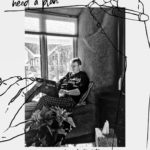 I was given “Writing Down the Bones” in my 20s, by my first girlfriend Trina, who was the first person to recognize me as a poet. This book gave me permission to call myself a writer and declare myself a poet. I recently listened to the 2005, 20th anniversary version of this book, with commentary and reflections by the author. Even though I’ve known this book was influential in my life, it was amazing to recognize how many of the practices continue to influence my writing and my creativity. Writing with a fountain pen, writing first drafts without correcting errors and carrying a notebook and pen in every bag, are three of many practices that are now second nature. This book is a must for anyone who writes, and a great gift for anyone with the heart of an artist.
I was given “Writing Down the Bones” in my 20s, by my first girlfriend Trina, who was the first person to recognize me as a poet. This book gave me permission to call myself a writer and declare myself a poet. I recently listened to the 2005, 20th anniversary version of this book, with commentary and reflections by the author. Even though I’ve known this book was influential in my life, it was amazing to recognize how many of the practices continue to influence my writing and my creativity. Writing with a fountain pen, writing first drafts without correcting errors and carrying a notebook and pen in every bag, are three of many practices that are now second nature. This book is a must for anyone who writes, and a great gift for anyone with the heart of an artist.
Ms. Boye
The War of Art by Steven Pressfield
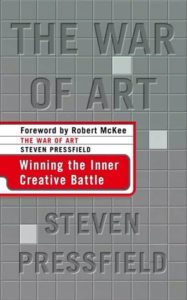 For Steven Pressfield, author of The War of Art, the obstacle that stands in the way of accomplishing any creative, personal, or professional goal we set our eyes upon is Resistance. Resistance is an insidious, invisible force that arises from within ourselves whenever we seek to fulfill a higher calling – as ambitious as writing a novel or as quotidian as a diet or workout routine. Pressfield repurposes the idea of “knowing one’s enemy” from Sun Tzu’s The Art of War to identify the many faces of Resistance, then outlines a strategic battle plan to defeat it – what he dubs “turning pro.” Last, he describes the sublime sources of inspiration unlocked once we begin to create our art, finish that project we’ve been putting off, or improve those aspects of ourselves we want to change. Concise and engaging, it’s a book you can read in an afternoon. If the inner critic, fear of failure, or procrastination impede your creativity, I highly recommend it!
For Steven Pressfield, author of The War of Art, the obstacle that stands in the way of accomplishing any creative, personal, or professional goal we set our eyes upon is Resistance. Resistance is an insidious, invisible force that arises from within ourselves whenever we seek to fulfill a higher calling – as ambitious as writing a novel or as quotidian as a diet or workout routine. Pressfield repurposes the idea of “knowing one’s enemy” from Sun Tzu’s The Art of War to identify the many faces of Resistance, then outlines a strategic battle plan to defeat it – what he dubs “turning pro.” Last, he describes the sublime sources of inspiration unlocked once we begin to create our art, finish that project we’ve been putting off, or improve those aspects of ourselves we want to change. Concise and engaging, it’s a book you can read in an afternoon. If the inner critic, fear of failure, or procrastination impede your creativity, I highly recommend it!
Eric Clow
The Everyday Work of Art, or How Artistic Experience Can Transform Your Life by Eric Booth
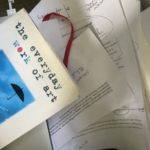 In the mid-1990s, I had the opportunity to work with the author Eric Booth as he organized his theories and practice for teaching artists in the United States. VSA (the international arts organization dedicated to inclusion of people with disabilities) was developing standards for including students with disabilities in arts education and instruction, and Eric was a key figure in our early conversations. I attended the first VSA Teaching Artist Institute in Georgia, where we filled the chapel walls with column upon column, row upon row of strategies, challenges, comments and solutions. It was an exhausting, but exhilarating time in our work, and it changed the trajectory of his work, and ours.
In the mid-1990s, I had the opportunity to work with the author Eric Booth as he organized his theories and practice for teaching artists in the United States. VSA (the international arts organization dedicated to inclusion of people with disabilities) was developing standards for including students with disabilities in arts education and instruction, and Eric was a key figure in our early conversations. I attended the first VSA Teaching Artist Institute in Georgia, where we filled the chapel walls with column upon column, row upon row of strategies, challenges, comments and solutions. It was an exhausting, but exhilarating time in our work, and it changed the trajectory of his work, and ours.
His book, published in 1997, is a comprehensive deep dive into his philosophy and practice of art as it moves us in everyday life. I remember him standing on the stage at the end of the five days, surrounded by the towering monument to the work that had occurred during those days, and bouncing up and down on his toes saying, “It all comes down to one thing, you’ve
got to ‘make stuff’.” In his book, Eric goes on to name it ‘world-making’ and defines it as “the master key to the work of art.” Through this book, I began to understand the everyday work of art – the habit, the practice, the world-making skills that are the cornerstone of any creative endeavor. It is not meant to be a text book, or a how-to guide, but merely a vehicle that “provokes and inspires readers rather than proves anything.” In this new year, let’s all hope that we can be provoked into making stuff every day.
Celia Hughes
Making an Entrance by Adam Benjamin
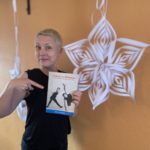 There are books that you read, and then there are the books that you read and reread. This book has been a cornerstone of my 15-year career. Not only is it a reliable source of ideas for my next class, but I also keep coming back to it for its beautiful and thought-provoking stories and experiences. Each reading unearths another gem or clarifies my understanding of a movement score at a deeper level. Some of my favorite exercises to teach or experience also come from Adam’s work, such as “Stretching a Point.” In 2017, while studying with Adam in Plymouth, and participating in this exercise, I remember being lifted with my eyes closed and carried so gracefully around the studio by my fellow participants, that it felt like flying. This book was published in 2002, and yet, its context is still wonderfully relevant. I recommend this book for anyone who wants to understand inclusive dance theory and practice.
There are books that you read, and then there are the books that you read and reread. This book has been a cornerstone of my 15-year career. Not only is it a reliable source of ideas for my next class, but I also keep coming back to it for its beautiful and thought-provoking stories and experiences. Each reading unearths another gem or clarifies my understanding of a movement score at a deeper level. Some of my favorite exercises to teach or experience also come from Adam’s work, such as “Stretching a Point.” In 2017, while studying with Adam in Plymouth, and participating in this exercise, I remember being lifted with my eyes closed and carried so gracefully around the studio by my fellow participants, that it felt like flying. This book was published in 2002, and yet, its context is still wonderfully relevant. I recommend this book for anyone who wants to understand inclusive dance theory and practice.
Silva Laukkanen
The Painter’s Keys by Robert Genn
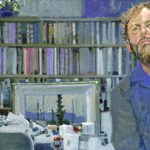 Not a new book by any means, having first been published decades ago, but an entertaining and very informative one which follows the teachings of Canadian artist and author Robert Genn shared during his well-known, two-day art seminars. A more 2020 description by Genn’s daughter is “a timeless, universal guide to lifesmanship masquerading as a painting blog.” I couldn’t agree more! I first read this book in the mid-90s at the recommendation of a beloved painting teacher. It was a period of time in which I was able to devote time and space to my painting practice, and immerse myself in classes and workshops to improve my craft. These days, opportunities to simply kick back and spend hours in front of a canvas, or scribble/type away on a script or story, are few and far between.
Not a new book by any means, having first been published decades ago, but an entertaining and very informative one which follows the teachings of Canadian artist and author Robert Genn shared during his well-known, two-day art seminars. A more 2020 description by Genn’s daughter is “a timeless, universal guide to lifesmanship masquerading as a painting blog.” I couldn’t agree more! I first read this book in the mid-90s at the recommendation of a beloved painting teacher. It was a period of time in which I was able to devote time and space to my painting practice, and immerse myself in classes and workshops to improve my craft. These days, opportunities to simply kick back and spend hours in front of a canvas, or scribble/type away on a script or story, are few and far between.
At the time I first read Genn’s book, it gave me fresh perspectives—how to find joy in productivity, find the inner child that is in all of us, determine one’s own level of quality in the art that one creates, find motivation when one needs it most, and many more ways to become more creatively effective. Genn’s writing style is accessible, and often humorous and anecdotal. It’s a great read and in writing this little review, I found myself rereading and being reminded why my 2021 New Year’s resolution is to make more art!
Susan Slattery
Art and Physics: Parallel Visions in Space, Time, and Light by Leonard Shlain
This wonderful book examines the connect between the artistic and the scientific discoveries of the modern age. Shlain builds an interesting parallel between the advances in science and how artists have sought to represent them in pictures. This narrative of art following science, and science being inspired by art, creates a unique way of seeing history and allows you to tickle both the creative and analytical sides of your brain. Shlain’s colorful writing style will leave you feeling inspired with a new understanding of art history that most text books leave out.
Jerry Slayton
The Art of Everyday Joe: A Collector’s Journal by Michael K. Corbin
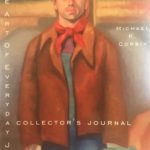 In thinking about a book that has inspired me creatively, my choice is a little odd, but let me explain. As an artist, I am always curious about what it is that draws a viewer to a piece of art or what makes them want to buy it. I love my art! But do others? And will they buy it – because my walls are getting crowded! What is an art collector looking for? What does an art collector look like? Where do I find them? This 2008 book reminds me that art collectors are looking for artists to create from their hearts so that the collectors can buy from their hearts. Art collectors are anyone and everyone – the “Everyday Joe!” This is a great book with short essays and lots of color art images to inspire you to create and feel confident that you aren’t the only one who likes your art!
In thinking about a book that has inspired me creatively, my choice is a little odd, but let me explain. As an artist, I am always curious about what it is that draws a viewer to a piece of art or what makes them want to buy it. I love my art! But do others? And will they buy it – because my walls are getting crowded! What is an art collector looking for? What does an art collector look like? Where do I find them? This 2008 book reminds me that art collectors are looking for artists to create from their hearts so that the collectors can buy from their hearts. Art collectors are anyone and everyone – the “Everyday Joe!” This is a great book with short essays and lots of color art images to inspire you to create and feel confident that you aren’t the only one who likes your art!
April Sullivan
The Artist’s Way: A Spiritual Path to Higher Creativity by Julia Cameron
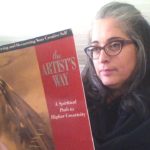 Celebrating its 25th year edition, The Artist’s Way is one of the best books about creativity. It is a self-help book written for people looking to start their artistic creative recovery. Using techniques and exercises, artists can gain self-confidence and learn to use their creative talents and skills. It’s an international bestseller and loved by millions—Julia Cameron is hailed as the Queen of Change by The New York Times, and it is a fitting title. In 2009, in between jobs (again), I took the book off my shelf and cracked the spine. The book had remained on the shelf unread for nine years. Originally, I bought it when the Dot.com bubble burst as I considered new career options. I graduated from art school but found myself in the high-tech industry, no longer doing creative work. That day in 2009 started me not only on a creative journey but a personal one too. For twelve weeks I did every exercise and used every technique until I knew that I wanted to be a writer and return to my first passion, visual arts. All these years later, I continue to use the tools I learned–my favorite being what Julia Cameron calls “morning pages” (three pages handwritten stream of consciousness writing) to clear the clutter out of your head and get on with your creative goals. It’s not a book to read for entertainment, it’s a guide to use when you are ready to change your life.
Celebrating its 25th year edition, The Artist’s Way is one of the best books about creativity. It is a self-help book written for people looking to start their artistic creative recovery. Using techniques and exercises, artists can gain self-confidence and learn to use their creative talents and skills. It’s an international bestseller and loved by millions—Julia Cameron is hailed as the Queen of Change by The New York Times, and it is a fitting title. In 2009, in between jobs (again), I took the book off my shelf and cracked the spine. The book had remained on the shelf unread for nine years. Originally, I bought it when the Dot.com bubble burst as I considered new career options. I graduated from art school but found myself in the high-tech industry, no longer doing creative work. That day in 2009 started me not only on a creative journey but a personal one too. For twelve weeks I did every exercise and used every technique until I knew that I wanted to be a writer and return to my first passion, visual arts. All these years later, I continue to use the tools I learned–my favorite being what Julia Cameron calls “morning pages” (three pages handwritten stream of consciousness writing) to clear the clutter out of your head and get on with your creative goals. It’s not a book to read for entertainment, it’s a guide to use when you are ready to change your life.
Gina P. Woodruff
What’s a creative book that’s inspired you?
Tell us about it in the comments or share with us on social media.
